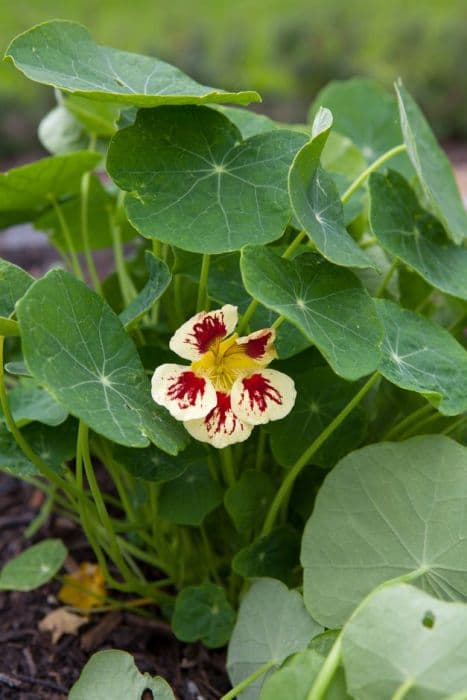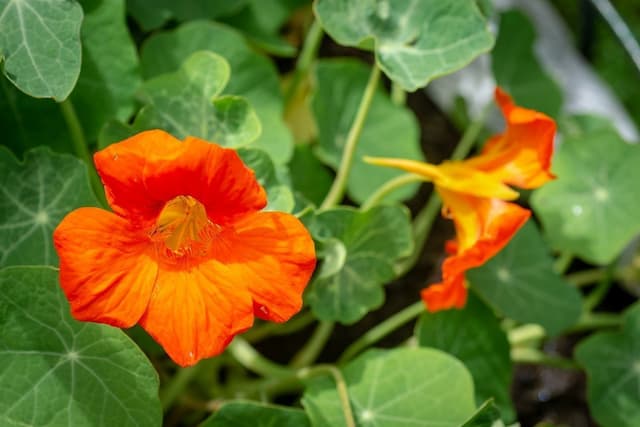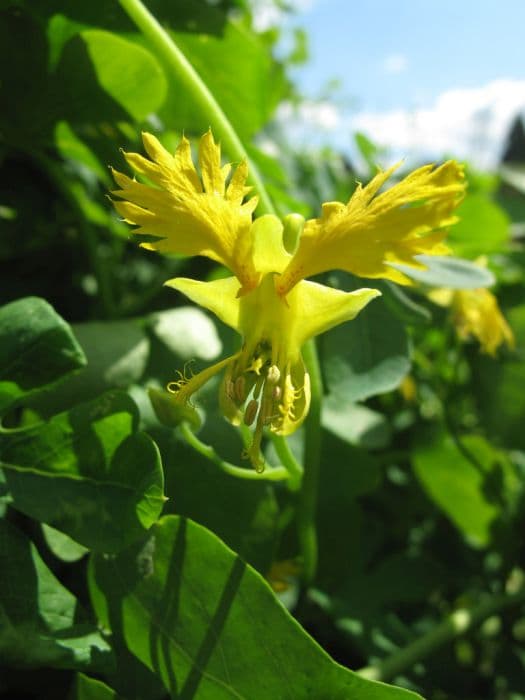Nasturtium Tropaeolum majus 'Chameleon'

ABOUT
The Tropaeolum majus 'Chameleon', commonly known as the Chameleon nasturtium, possesses a strikingly vibrant and variable appearance that makes it a distinctive addition to any garden setting. With a name like 'Chameleon', it aptly reflects its unique characteristic—the ability to bear flowers of different colors all on the same plant. The blooms exhibit a mix of warm hues including reds, oranges, yellows, and creams, often featuring a delightful mottling or blending of shades that can change depending on the light and growing conditions, much like the color-changing skin of its namesake reptile. Beyond the attractive flowers, the Chameleon nasturtium displays rounded leaves that are nearly as decorative as the blossoms themselves. These leaves are characterized by their lush, green color and a fairly large, shield-like shape with smooth edges, typically supported on long, slender stems that may intertwine or cascade, depending on their environment. Together, the showy, diverse flowers and the broad, green foliage create a splash of enduring color throughout the blooming season, and this versatile plant is equally at home climbing, trailing from a container, or spreading out as ground cover. Furthermore, the entire plant is known for its peppery flavor, adding not only visual appeal but also a zesty note to culinary uses, from salads to garnishes.
About this plant
 Names
NamesFamily
Tropaeolaceae.
Synonyms
Garden Nasturtium, Indian Cress, Monks Cress.
Common names
Tropaeolum majus
 Toxicity
ToxicityTo humans
Nasturtium, specifically the Tropaeolum majus 'Chameleon', is generally considered safe for human consumption. In fact, the leaves and flowers are often eaten in salads for their peppery flavor. However, some individuals might experience stomach upset or gastrointestinal discomfort if they consume large amounts of nasturtium, or if they are sensitive to the plant. It is not generally considered toxic, and significant poisoning from nasturtium is rare.
To pets
Nasturtium is not listed as toxic to pets by major animal poison control resources. Pets (such as dogs and cats) may experience mild stomach upset if they consume large amounts of the plant, due to the unusual flavors and compounds found in nasturtiums, but it is not considered a poisonous plant with severe conscequences. Owners should always monitor their pets and discourage them from eating large quantities of any non-food plants.
 Characteristics
CharacteristicsLife cycle
Annuals
Foliage type
Deciduous
Color of leaves
Varies
Flower color
Mixed
Height
1 feet (30 cm)
Spread
1 feet (30 cm)
Plant type
Herb
Hardiness zones
9
Native area
South America
Benefits
 General Benefits
General Benefits- Edible Parts: Nasturtiums have edible leaves and flowers, which can add a peppery taste to salads and garnishes.
- Easy to Grow: They are easy to cultivate, either in the garden or in containers, making them accessible for gardeners of all skill levels.
- Attracts Pollinators: The vibrant flowers attract beneficial pollinators like bees and butterflies, aiding the pollination of nearby plants.
- Companion Planting: Nasturtiums are often used in companion planting to deter pests from other crops with their strong scent.
- Culinary Uses: The leaves, flowers, and unripe seed pods can be used in a variety of culinary dishes for added flavor and decoration.
- Landscape Beautification: With their vivid colors and unique appearance, they are excellent for beautification in garden beds, borders, and as ground cover.
- Temporary Ground Cover: They can quickly cover bare spots in the garden, providing temporary ground cover while other plants establish.
- Natural Dye: The flowers can be used to make a natural yellow or orange dye for fabrics or foods.
 Medical Properties
Medical Properties- Antibacterial: Tropaeolum majus, commonly known as Nasturtium, contains compounds that may exert antibacterial effects.
- Antifungal: Some studies suggest that Nasturtium may have antifungal properties.
- Expectorant: Traditionally, Nasturtium has been used to loosen phlegm in the respiratory tract.
- Vitamin C source: Nasturtium leaves are known to be high in vitamin C, which is important for immune system function.
- Wound healing: Topical application of Nasturtium extracts has been traditionally used to promote wound healing due to potential antimicrobial and healing properties.
- Diuretic: Nasturtium has been traditionally used to promote diuresis, potentially aiding in the removal of excess fluids from the body.
 Air-purifying Qualities
Air-purifying QualitiesThis plant is not specifically known for air purifying qualities.
 Other Uses
Other Uses- Nasturtiums can be used as a caper substitute. Their unripe seeds can be pickled and used as a culinary alternative to capers.
- The flowers of nasturtiums are often incorporated into ice cubes to add a pop of color and mild peppery flavor to summer drinks.
- Nasturtiums can serve as a trap crop in gardens, luring aphids away from more delicate plants that are susceptible to pest damage.
- The large leaves of the nasturtium can be used as a natural wrap, similar to grape leaves, for cooking or serving rice and other fillings.
- Nasturtiums can be blended into butter to create a unique, flavorful spread with a hint of spice and vibrant color.
- When used in companion planting, nasturtiums can help to improve the growth and flavor of various vegetables, such as tomatoes and cucumbers.
- Dried nasturtium flowers can be used in potpourri mixes to add a visual element due to their bright colors.
- As a natural dye, nasturtiums can impart a yellow to orange tint to fabrics and papers when used in the dyeing process.
- Nasturtium blooms can garnish cakes and pastries not only adding beauty but also a touch of an edible zesty flavor.
- The seeds of nasturtiums can be ground up and mixed with other spices to create a peppery seasoning for dishes.
Interesting Facts
 Feng Shui
Feng ShuiThe Nasturtium is not used in Feng Shui practice.
 Zodiac Sign Compitability
Zodiac Sign CompitabilityThe Nasturtium is not used in astrology practice.
 Plant Symbolism
Plant Symbolism- Conquest or Victory in Battle: The common name of Tropaeolum majus 'Chameleon' is Nasturtium, which derives from the Latin words "nasus tortus," meaning "twisted nose," a reference to the effect on the nose of the mustard oils in the leaves. Its name is related to the trophy pole ("tropaeum") where Roman soldiers would hang the armor of their defeated enemies. This connection gives Nasturtium the symbolic meaning of conquest or victory in battle.
- Patriotism: Nasturtiums can be seen as a symbol of patriotism, given their long-standing inclusion in gardens and the historical symbolism of their name related to battle and conquest.
- Vitality and Energy: The bright and vibrant colors of Nasturtium flowers, which can change in response to the environment, mirror the idea of vitality and energy, making them symbolize a zest for life.
- Optimism and Positivity: The cheerful appearance of Nasturtium blooms are often associated with optimism and positivity, as they can lift spirits with their vivid colors and bold presence in a garden setting.
 Water
WaterNasturtiums require moderate watering and prefer to be watered directly at the base to avoid wetting the foliage, which can lead to fungal diseases. During the active growing season in spring and summer, water thoroughly once a week, ensuring that the soil is moist but not soggy. If the weather is particularly hot or dry, increase watering to twice a week, providing about one gallon per plant each time. Reduce watering in the fall and winter when the plant is not actively growing.
 Light
LightNasturtiums thrive in full sun to partial shade. The ideal spot for a nasturtium would be one where it receives at least 6 hours of sunlight per day, but it can also tolerate some light afternoon shade, especially in hot climates. Avoid deeply shaded areas, as this can lead to leggy growth and fewer blooms.
 Temperature
TemperatureNasturtiums grow best in cooler temperatures ranging from 55 to 75 degrees Fahrenheit but can survive temperatures as low as 40 degrees and as high as 85 degrees. They do not do well in extreme heat, and in hot summer climates, they prefer partial shade to protect them from the intense afternoon sun.
 Pruning
PruningNasturtiums benefit from occasional pruning to promote bushier growth and more blooms. Pinch off the tips of young plants to encourage branching and cut back any leggy stems throughout the season. Prune the plant after it has finished blooming, usually in late summer or early fall, to tidy up the appearance and prepare it for the next growing season.
 Cleaning
CleaningAs needed
 Soil
SoilNasturtium 'Chameleon' thrives best in a well-draining soil mix with a pH range from 6.1 to 7.8. A mixture of garden soil, peat, and perlite in equal parts can provide the adequate drainage and aeration needed. Be sure not to over-enrich the soil with organic matter or fertilizers as nasturtiums prefer poorer soils, which can encourage more foliage growth at the expense of flowers.
 Repotting
RepottingNasturtiums 'Chameleon' typically do not require frequent repotting and do well if they are slightly root-bound. They should be repotted every two to three years or if you notice that the plant's growth has significantly slowed down or it looks less vibrant. Always ensure that the new pot has excellent drainage.
 Humidity & Misting
Humidity & MistingNasturtium 'Chameleon' is adaptable to a range of humidity levels and does not require high humidity to flourish. It performs well in the average humidity found in outdoor environments and can tolerate the drier conditions often found indoors without any special humidity adjustments.
 Suitable locations
Suitable locationsIndoor
Place in bright, indirect light and water moderately.
Outdoor
Plant in full sun to part shade; well-draining soil.
Hardiness zone
9-11 USDA
 Life cycle
Life cycleTropaeolum majus 'Chameleon', commonly known as Nasturtium 'Chameleon', begins its life cycle when its seeds are sown in the soil after the last frost, typically in early spring. These seeds germinate within 10-14 days, depending on conditions like warmth and moisture. Following germination, Nasturtium 'Chameleon' quickly develops into a seedling with a pair of distinctive, rounded leaves. As the plant grows, it forms a lush, spreading mound or trailing vines with broad leaves and a profusion of variable-colored flowers that can range from yellow to orange and red, often with unique patterns on each individual flower. The flowering stage occurs from early summer to fall, during which time the plant can also self-seed if the conditions are favorable. After blooming, assuming no killing frost, Nasturtium 'Chameleon' will set seed before dying back at the onset of winter, completing its annual life cycle.
 Propogation
PropogationPropogation time
Spring-Early Summer
The most popular method of propagation for Tropaeolum majus 'Chameleon', commonly known as Nasturtium, is through seed sowing. The ideal time for sowing Nasturtium seeds is in the spring after the last frost has passed when the soil has warmed to at least 55 degrees Fahrenheit (about 13 degrees Celsius). Plant seeds directly into the garden or outdoor containers about 1/2 inch deep (approximately 1.3 centimeters) and spaced about 10 to 12 inches apart (25 to 30 centimeters). Nasturtium seeds have a hard seed coat, so to facilitate quicker germination, it's beneficial to either soak the seeds in water overnight or gently file the seed coat before planting. Seeds typically germinate in 7 to 14 days. Seedlings usually do not require transplanting, which makes direct sowing a convenient method of propagation for this particular plant.


